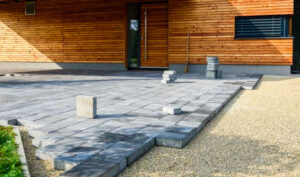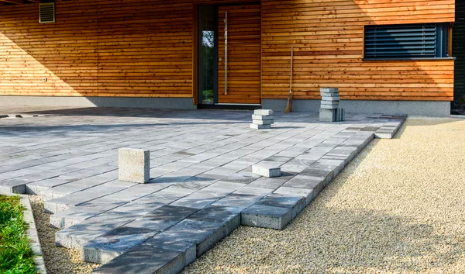 Paved driveways are a smart investment for homeowners. They’re simple to shovel in winter and convenient to park on all year round.
Paved driveways are a smart investment for homeowners. They’re simple to shovel in winter and convenient to park on all year round.
Before paving, it’s important to call 8-1-1 and have a professional check for underground utility lines. They can also provide a sample specification to follow. Contact Driveway Paving Charleston SC for professional help.
Many paving materials have color, size, pattern and finish choices. Some are porous, allowing water to pass through instead of pooling on top of the surface.
The cost of driveway paving can vary, depending on the material you choose and how much work is needed to get it ready. Many contractors will quote you a price per square foot, and you can compare quotes from different companies before you decide. Some paving companies may also include the cost of removing your existing driveway in their bid. Before you sign any contracts, make sure you understand the exact costs and ask the contractor about any hidden fees or charges. You should also take into account your location and the climate in your area, as these factors can affect the cost of your paved driveway.
There are several types of paving materials to consider for your new driveway, and each type offers different benefits. For example, cobbles or setts can add a classic look to your home, while slate and granite offer a more contemporary appearance. You should also consider the design of your driveway, as a paved surface that matches the style of your house will look best.
Concrete is a popular choice for paved driveways, but it can be expensive. It is important to find a reputable company that has experience working with your type of paving, and you should ask for an estimate before the project begins. You should also consider the cost of excavation and removal of your existing driveway, as well as the labour involved in laying the concrete.
Asphalt is another common option for a new driveway, and it can be less expensive than concrete. However, it can be prone to cracking and require frequent sealing. In addition, if your driveway is on an incline, it will be more difficult to maintain a smooth surface.
Traditional gravel is another low-cost paving option. It is available in a variety of colors and provides a natural look that can match your home’s landscaping. However, it can be muddy during rainy weather and is susceptible to weed growth. It is also not a good choice if you have tree roots growing into the surface.
Brick pavers are an elegant and upscale option, but they can be quite expensive. They also need to be resealed regularly to prevent staining. Permeable pavers are another paving option that allows storm water to filter back into the ground. They are more eco-friendly than solid paving materials, but they can be clogged by sand and silt.
Materials
When it comes to paving your driveway, there are many options to consider. The best choice depends on the look you want to achieve, your climate and other factors such as how difficult it will be to plow snow off your drive in the winter. In addition, the size and shape of your driveway will influence which type of material is best for you. For example, if you are looking for a modern look, you may want to choose a concrete driveway. However, if you are on a budget, a gravel driveway can work just as well.
Paver blocks are an attractive option for a driveway, and they can be customized to suit your taste. They are also hard-wearing and can resist harsh weather conditions. However, you should always check whether the stones are sourced from a local quarry and that the provider followed environmental protections during excavation. In addition, you should always consider a drainage system to prevent water from running off the paved surface.
Another popular paving choice is brick. The material is long-lasting and can withstand the weight of vehicles. It is also affordable and comes in a variety of colors, sizes, and textures. In addition, it can be stamped to resemble more expensive materials like stone or clay brick.
If you’re looking for a more natural feel, you can opt for sandstone pavers. These are available in a range of different styles, and they’re ideal for achieving a rustic or cottage-style look. They are also durable and easy to maintain, but you should always seal them before rainy weather hits.
Gravel is an excellent alternative to paved driveways, and it’s relatively cheap and environmentally friendly. It’s typically made from crushed rock or sorted aggregate with pieces 1 to 2 inches in diameter. You can mix it with decorative elements like pebbles and boulders to enhance its visual appeal.
A tarmac driveway is another good option for a driveway, as it’s easy to repair and can handle high volumes of traffic. It’s also resistant to salt and other chemicals, so it can withstand the winter weather. However, tarmac is not ideal for pedestrians or families with small children, as it can be slippery and dangerous to walk on.
Installation
A new paved driveway can make your property more attractive, increase its value and improve its overall appearance. However, it can be a costly project, so it is important to choose the right materials and installation process. A good paving contractor will take the time to assess your needs and provide you with the best options for your budget. Some of the most popular options include herringbone, running bond stacked bond basket weave and pinwheel pavers.
Before you start the paving process, it is best to run a soil percolation test. This will give you an idea of the soil composition and drainage capacity, which will help you decide if your driveway needs to be laid on a deeper base or extra drainage solutions.
Once the ground is prepared, it is important to install a proper foundation. The base should be made of gravel and compacted using a hand tamper. This layer will ensure that the pavers stay in place and prevent them from shifting over time. The base should also be leveled and smoothed out evenly.
The next step in the paving process is to lay a layer of sand on top of the gravel base. This will help keep the pavers in place and make them watertight. It is also a great option for colder climates, as it will keep snow from building up on the pavement and protect the surface.
After laying the sand, it is important to install edge restraints to hold the pavers in place. These can be in the form of metal strips or timber blocks. The restraints can be cut to match the edges of your design pattern, if needed.
Once you have the pavers in place, you can add a layer of joint sand to enhance stability and ensure that the joints are filled in completely. This is also a good opportunity to apply an acrylic sealant, which will preserve the color of the paving stones and extend their lifespan.
Proper drainage is essential for your paved driveway, as standing water can wear away at the materials and lead to expensive repairs in the future. You should ask your paving contractors to install a two percent slope and pipe cross drains.
Maintenance
A driveway is an important part of your home, and its appearance can affect the curb appeal of your property. Whether you choose an asphalt or concrete pavement, proper maintenance is critical to keeping your driveway looking good and lasting for years. Regular inspections and cleaning help to identify issues and prevent further deterioration. It is also important to maintain proper drainage around your driveway to prevent water from accumulating and damaging the surface.
In the case of block paving, a standard cleaning regime should include sweeping and occasional use of a pressure washer at a low setting (not so powerful as to dislodge or damage the individual blocks). Weed control products can be used in some cases but these must be applied according to manufacturer instructions. If gaps between blocks appear you may wish to top up with filler sand in order to make the surface flush.
If you notice oil stains, these should be dealt with as soon as possible to prevent the penetration of the stain into the underlying tarmac. Using hot soapy water on the affected area should remove them with ease, however it may be necessary to soak up the excess with dry cloths or paper towels. In some cases, a mild degreaser can be used to help remove stubborn oil stains from the paving surface.
A visual inspection of your driveway should take place on a regular basis to monitor its condition and look for cracks and potholes. Ideally, these should be dealt with promptly to minimize the damage to your driveway and reduce repair costs.
Regular inspections are also helpful in identifying problems such as drainage issues, which can lead to damage to the underlying soil and cracking of the paving material. In some cases, these problems can be addressed by a simple drain gully installation to direct water away from the pavement.
A reputable paving contractor will be able to advise you on the best solution for your driveway. It is essential that you ask the paving contractor questions if you are not sure about anything and ensure that the answers are clearly explained in easy-to-understand terms.

